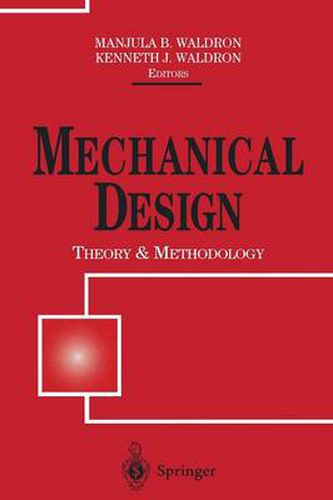Readings Newsletter
Become a Readings Member to make your shopping experience even easier.
Sign in or sign up for free!
You’re not far away from qualifying for FREE standard shipping within Australia
You’ve qualified for FREE standard shipping within Australia
The cart is loading…






This title is printed to order. This book may have been self-published. If so, we cannot guarantee the quality of the content. In the main most books will have gone through the editing process however some may not. We therefore suggest that you be aware of this before ordering this book. If in doubt check either the author or publisher’s details as we are unable to accept any returns unless they are faulty. Please contact us if you have any questions.
This volume, Mechanical Design: Theory and Methodology, has been put together over the past four years. Most of the work is ongoing as can be ascertained easily from the text. One can argue that this is so for any text or monograph. Any such book is only a snapshot in time, giving information about the state of knowledge of the authors when the book was compiled. The chapters have been updated and are representative of the state of the art in the field of design theory and methodology. It is barely over a decade that design as an area of study was revived, mostly at the behest of industry, government, and academic leaders. Profes sor Nam Suh, then the head of the Engineering Directorate at the National Science Foundation, provided much of the impetus for the needed effort. The results of early work of researchers, many of whom have authored chapters in this book, were fundamental in conceiving the ideas behind Design for X or DFX and concurrent engineering issues. The artificial intelli gence community had a strong influence in developing the required com puter tools mainly because the field had a history of interdisciplinary work. Psychologists, computer scientists, and engineers worked together to under stand what support tools will improve the design process. While this influ ence continues today, there is an increased awareness that a much broader community needs to be involved.
$9.00 standard shipping within Australia
FREE standard shipping within Australia for orders over $100.00
Express & International shipping calculated at checkout
This title is printed to order. This book may have been self-published. If so, we cannot guarantee the quality of the content. In the main most books will have gone through the editing process however some may not. We therefore suggest that you be aware of this before ordering this book. If in doubt check either the author or publisher’s details as we are unable to accept any returns unless they are faulty. Please contact us if you have any questions.
This volume, Mechanical Design: Theory and Methodology, has been put together over the past four years. Most of the work is ongoing as can be ascertained easily from the text. One can argue that this is so for any text or monograph. Any such book is only a snapshot in time, giving information about the state of knowledge of the authors when the book was compiled. The chapters have been updated and are representative of the state of the art in the field of design theory and methodology. It is barely over a decade that design as an area of study was revived, mostly at the behest of industry, government, and academic leaders. Profes sor Nam Suh, then the head of the Engineering Directorate at the National Science Foundation, provided much of the impetus for the needed effort. The results of early work of researchers, many of whom have authored chapters in this book, were fundamental in conceiving the ideas behind Design for X or DFX and concurrent engineering issues. The artificial intelli gence community had a strong influence in developing the required com puter tools mainly because the field had a history of interdisciplinary work. Psychologists, computer scientists, and engineers worked together to under stand what support tools will improve the design process. While this influ ence continues today, there is an increased awareness that a much broader community needs to be involved.